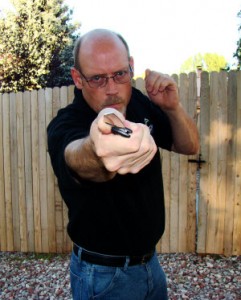In my previous article, Making the Cut, I discussed the mechanics of combative cutting with a knife. Based on that understanding, let’s take a look at the other side of the equation: thrusting.
First, let’s get the semantics out of the way. Whether you prefer to call it “thrusting,” “stabbing,” “sewing machine,” or anything else is up to you. Just as I prefer to call all variants of cutting technique simply “cutting,” I refer to tactics that involve penetration with the point of a knife (or similar weapon) as “thrusting.”

Step 1. Author demonstrates a high-line comma-cut thrust. It begins by chambering near the right shoulder.
The Resistance of Human Skin
The first consideration in thrusting is the ability of a knife point to puncture human skin. There have been a number of different medical studies done on this topic, but the most authoritative I’ve seen was one that my late friend Chris Grosz (researcher and co-author of Contemporary Knife Targeting) came across in his research. A research team at the Welsh National School of Medicine, University of Wales, constructed a device that measured the pressure that had to be applied to the handle of a knife while its point was pushed through a target. The testing media for this research were actual human cadavers that were scheduled for autopsies.
Various types of knives were mounted into the measuring device and used to make the initial penetration for the autopsy through the bare skin of the thoracic cavity down the midline of the abdomen. In each case, the force required to achieve penetration of the skin was precisely measured and recorded.

Step 2. Using the tip of the thumb as a guide, the knife is thrust toward the target in an arcing motion.
This study also determined that “an acutely pointed dart-like weapon can be introduced more easily than a knife with an obtusely curved extremity, even though the cutting edge of the curve may be very sharp.” As such, blades with significant “belly” did not penetrate as well as those with acute points located closer to the midline of the knife.

Step 2. Using the tip of the thumb as a guide, the knife is thrust toward the target in an arcing motion.
Later tests used this same basic methodology to assess the effects of clothing on the force required. Once again, the sharpness of the weapon’s point was the most important determining factor, and “only sharp blades could penetrate clothing.”
Practical Guidelines
If we take the results of this medical testing and put them into the realistic context of knife tactics, several things become readily apparent:
- Penetrating bare skin with a sharp knife requires very little force, especially with ballistic thrusting.
- Penetrating the tissue under the skin also requires very little force once the skin itself is punctured.
- Penetrating the outer clothing is the real challenge in thrusting.
- The sharpness and acuteness of a knife’s point are the keys to achieving penetration in thrusting.
With all that in mind, let’s first clarify why we thrust: to penetrate clothing and gain access to the underlying tissue so we can cut it to achieve a predictable physiological stop. The perfect example of this, as well as an ideal way of understanding the preferred mechanics of thrusting, is targeting the quadriceps muscle at the front of the thigh within the first six or so inches above the knee. As discussed in previous PDN articles and my other teachings, this is one of the key targets in the Martial Blade Concepts (MBC) system, because it immediately destroys the attacker’s ability to extend his knee joint and support weight on that leg. By destroying his mobility, you can now create distance and safety.
Proper Thrusting Technique
It is certainly possible to thrust using a linear motion or a simple pendulum-style swing of the arm. This would create a penetrating wound and withdrawal of the blade that is essentially the reverse path of the entrance. As such, the resulting wound channel would be the shape of the blade.

Step 6. At the completion of the movement, the blade is chambered near the left shoulder in a palm-up position.
To begin the thrust, chamber your knife hand near your right hip with the palm facing down. Driving with the power of your hips and shoulders (like a boxer throwing a hook punch), thrust the knife on a tight inward arc so the point would make contact toward the inner side portion of the attacker’s thigh. Keep your wrist locked straight and your elbow slightly bent. The powerful mechanics of this motion should allow the blade to penetrate the pant leg, skin, and underlying tissue very easily. A primary reason for this is that the point penetrates the pant leg at an angle that is nearly perpendicular to its surface and the surface of the skin. Even if very loose, the pant leg cannot move with the blade to dissipate the force, which it can with a lateral cutting motion.
Once the blade has achieved penetration, drop your right elbow to your ribs. This rotates your hand to a palm-up position and rotates the blade in the target material so the edge is now facing to your left. Again, using the power of your hips, rotate at the waist while keeping your elbow tight to your side. This motion creates a powerful right-to-left cutting force that laterally cuts out of the initial wound channel created by the thrust. As the blade clears the target, allow your hand to naturally follow through and come to a palm-up chamber position near your left hip.
When executed in this way, this thrusting tactic yields what I call a “Comma Cut.” Like a comma in punctuation, the wound is shaped like an arc, with the concave side on the left. When performed very well, the shape is more analogous to a backward Nike® “swoosh” symbol.
In this specific application, the goal is to cut the quadriceps muscle to achieve a mobility kill. The initial thrust facilitates penetration of the pant leg, the skin, and the underlying tissue. When the elbow drops, the edge orients forward and in all likelihood cuts forward to contact the femur. The finishing portion of the motion then allows the edge to continue to cut, severing the muscle down to the bone.
Compensating for a Miss
Due to the dynamic nature of close combat, it is very possible that your thrust could miss its mark. Instead of penetrating the inner portion of the thigh, your knife point could miss and end up behind the attacker’s thigh. This is where the built-in physiological potential of this method of thrusting becomes apparent.
Rather than simply retracting your hand and weapon, continue the exact same sequence of actions as if your thrust had been successful. Dropping your elbow turns your hand palm up and indexes the cutting edge against the attacker’s thigh with great pressure. Completing the motion by rotating the hips and shoulders results in a powerful pressure cut and the reliable stopping power we’re trying to achieve.
Countering a Barrier
What if your attacker reacts quickly and stops your thrust with a downward forearm block? Again, the inherent mechanics of the technique provide an immediate solution. Rather than retracting, you again drop your elbow to orient the edge against his arm. Rotate your hips to power the cut, which now targets the attacker’s arm rather than his leg, leaving you chambered near your left hip for a natural backhand follow-up to your original target.
The action of the thrust and comma cut can also hook the blocking arm with the butt of your knife, moving the arm out of the way rather than cutting it. Again, your follow-through will leave you chambered for an immediate backhand cut.
Foiling a Grab
The physiological potential of proper thrusting technique also includes a powerful natural counter against a wrist grab. If the attacker grabs your wrist in an attempt to control your weapon hand, execute the thrust and comma cut as planned. The power generated by your hip turn, the torque of the rotation of your hand, and the fact that you’re working against the weakest part of his grip (where his fingers and thumb come together) will easily break the grip and leave you chambered for another cut. One excellent follow-up cutting sequence from this counter-grab is to target the biceps muscle of the grabbing arm, followed by another comma cut thrust to the quadriceps.
Thrusting to the thigh is a low forehand attack, or angle 3 in the MBC system. Once you’re comfortable with the mechanics of that angle, apply them to the other angles of attack, which include high forehand and backhand motions and a low backhand. In each case, emphasize the dropping of the elbow, the turning of the hand from palm up to palm down (or vice versa), and the rotational power generated by the hips and shoulders. With a little practice, you’ll find that it’s very easy to integrate proper angular thrusting technique into your knife tactics. Doing so will not only maximize the effect of your thrusts, it will also provide an entire spectrum of other combative functions based on the physiological potential of the mechanics of the thrust. One of the guiding principles of my approach to combative skills is “Have a plan, and work your plan.” Good thrusting technique is an excellent example of that concept.Related Video:


I think there's a hole in your shirt revealing your armpit.